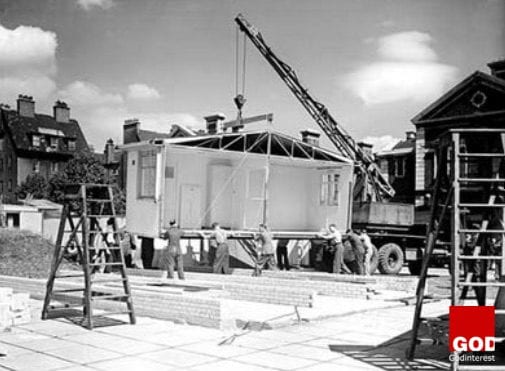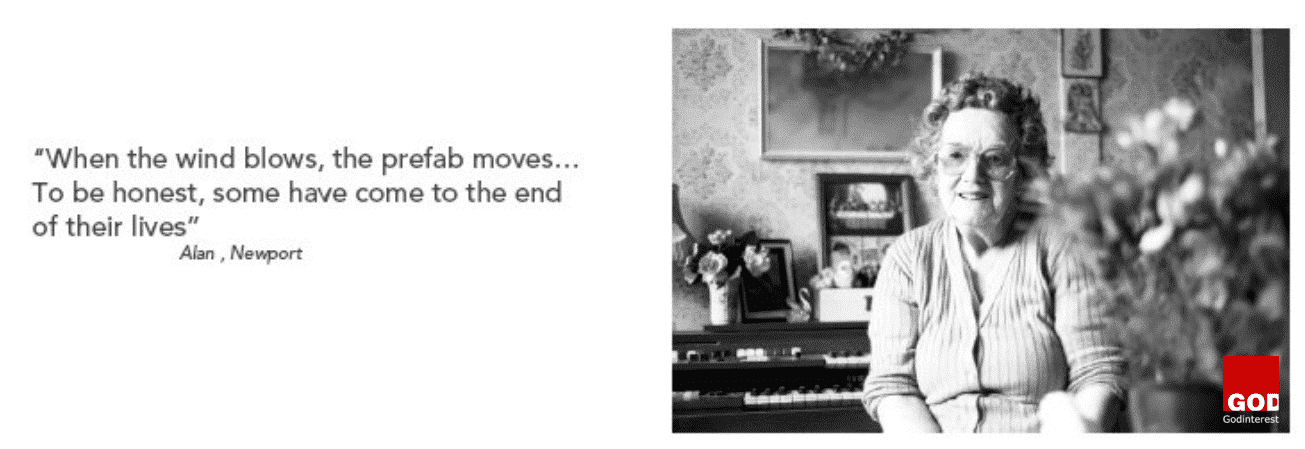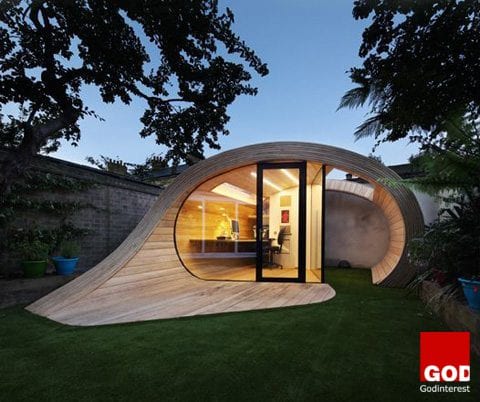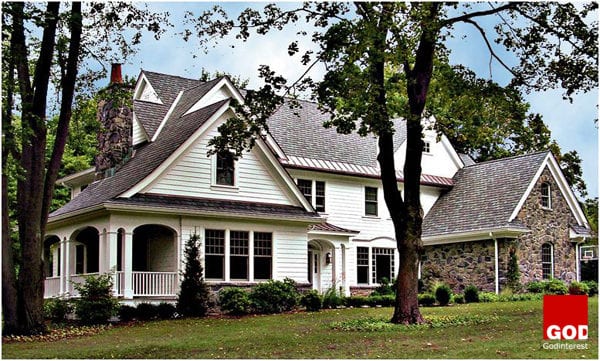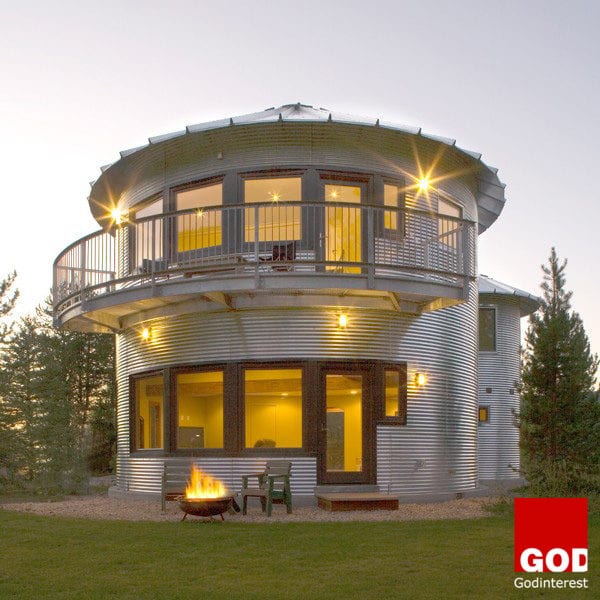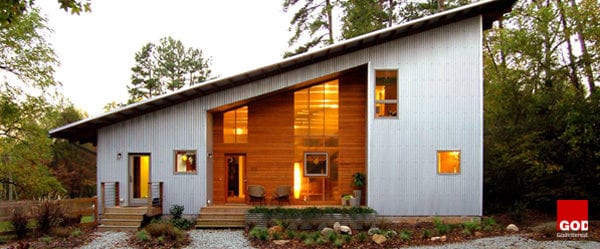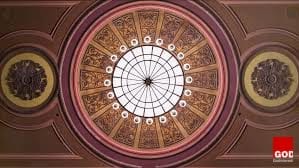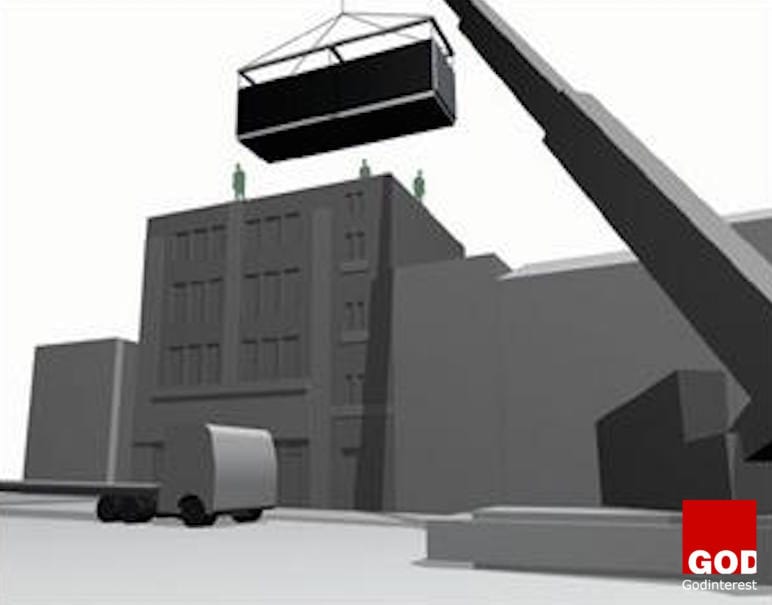Bridge House, Croydon, Is Prefab Really Prefabulous?
Prefabricated homes have been available for years and date back at least a century. The Sears Roebuck index made and offered prefab homes to the public as early as 1908, and Prefab was later explored by famous twentieth-century architects, such as, Walter Gropius, Le Corbusier, Marcel Breuer, Frank Lloyd Wright, who saw the method as a likely solution to the dilemma of housing in modern society. Interest in Prefab grew in the first half of the twentieth-century, with the outburst of manufacturing expertise and the creation of the assembly line.
Historically the mention of prefabricated houses invokes memories of housing built to cover in the temporary a deficiency of housing in the UK following the World Wars.
The Government promised ‘homes fit for heroes’, however, negative public attitudes surfaced towards prefabricated housing because of substandard building materials used and poor workmanship.
A staggering 1 million of these homes were built during the 20th century and more than half a century on, many are still standing despite no foundations. A few are listed while others have been demolished.
Today people remember the shabby mobile classrooms as in, bitter cold in winter and like an oven in summer. Therefore, memories have rendered the concept of prefabricated houses an unattractive idea. Talk about the term prefabricated housing to an architect, and their eyes will beam with visions of fascinating contemporary homes. However, talk to the ordinary person on the street and people immediately think that we are going down the same path, a pretty hard image to shake off. The very factors that are presented as positive advantages of prefabricated homes became liabilities in the eyes of homeowners who wanted a durable appreciating asset.
An example can be found by looking at the prefabricated houses on Catford estate built by German and Italian prisoners of war in 1946.
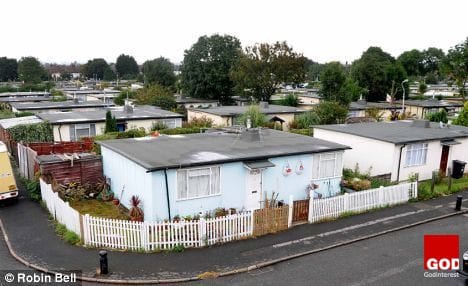
‘They were not built to last and need regular maintenance. They are just large sheds really and taking up a lot of space. They should really be demolished.’ (Drake 2008)
Over the ten years, Lewisham Council has tried to develop the site many times and a review found none of the dwellings met Decent Homes Standard.
So why do more and more developers choose prefabricated construction?
First and foremost – Speed. “It may take a bit longer in terms of design, preparation and planning but site based activities are taking up to 30% less time and allowing homes to reach the market sooner. Other reasons cited include, in order of preference:
- Design Quality
- Cost
- Previous Experience
- Funding
Source: Design and Modern Methods of Construction. The Housing Corporation and CABE 2004″
Bridge House (Example)
Croydon Vision 2020 is a regeneration programme by the London Borough of Croydon for the centre of Croydon in South London. The Old Town Masterplan focused on the area between the High Street and Roman Way, one of the oldest areas of Croydon.
Formerly the site of a telephone exchange, Bridge House is a £20 million development that has provided 27 private and 48 affordable apartments, above ground and mezzanine retail spaces.
The block wraps around an existing multi-storey car park and offers the opportunity for cafs and shops to open onto the new square. A mix of green and brown roofs, to support biodiversity, form part of a series of environmental measures and the scheme is to be of modular construction.
The Croydon chose the modular approach principally because of the speed of construction offered. The project began on site in the spring of 2006 and the 75 flats were stated to have been erected in approximately 26 days, vastly outperforming the time taken by traditional construction.
Client: Howard Holdings plc
Architect: AWW
Structures: Walsh Associates
Principal Supplier: MC First
Modular Penthouse, Wandsworth High Street
Generous glazed areas and therefore naturally lit apartments with fine views out are an extremely desirable part of the modern home. A common misconception and criticism of prefabricated modules is that they offer little opportunity for large glazed facades. Atelier One have proved this is clearly not the case on previous projects such as the rooftop extension to The White Cube Gallery in Hoxton Square and on their work on the Piper Building, Fulham. The key to glazing prefabricated modules is to provide enough stiffness to eliminate movement when the modules are transported.
Modular Penthouse, Wandsworth High Street
Architect: Martin Markcrow Architects
Structural Engineer: Buro Happold
Quantity Surveyor: KMCS London
Model Photography: Andrew Putler
This new two-storey penthouse is located above an existing four-storey building on Wandsworth High Street, London, within a Conservation Area.
The 2,400 sq ft apartment for private clients was pre-fabricated in Slovenia, and transported as five separate 12.0m long modules to London, where they were craned into position over a 2-3 day period, before connection to the existing services and stairwell. The steel framed structure minimised the load on the existing building and afforded strength during transportation and lifting. A modular construction route was chosen primarily to avoid disruption, noise, and dust pollution to the clients who occupied the top floor of the building. In addition, a conventional construction route with scaffolding and temporary shelter on this constrained site proved particularly difficult and costly.
13 Basic Facts You Should Know about Modular Homes
Modular homes sometimes referred to as “factory-built construction“, encompass a category of housing built in sections typically at a factory location. These houses must conform to local and regional building codes for the country the buyer plans to situate the dwelling.
Just like site-built housing, construction teams build modular homes to last and increase in value over time. As the factory finishes building sections of the house, each piece is transported to the homeowners build site on large truck beds. Local building contractors then assemble the house and inspectors ensure the manufacturer has built your residence to code. Most customers find that modular housing is less expensive than site-built homes.
1. Benefits of Construction
One of the benefits of construction is that manufacturers build them indoors in an enclosed factory setting, where the materials used to build the homes are not subject to adverse weather during construction.
Most building contractors can finish erecting a house in as little as 1-2 weeks, though it may take up to 4 weeks or more for local contractors to finish building the dwelling on-site once it has been delivered.
2. Differences Between Modular and Site Built
Modular homes are not the same as site-built homes, which contractors create 100% at the build site. That means the
contractor must collect all the materials for a house and built it on-site. Like a modular home, the site-built home must conform to all regional, state and local building codes. Many refer to site-built construction as stick-built homes. Stick built housing is also well-built and designed to last a lifetime.
3. Difference Between Modular and Manufactured
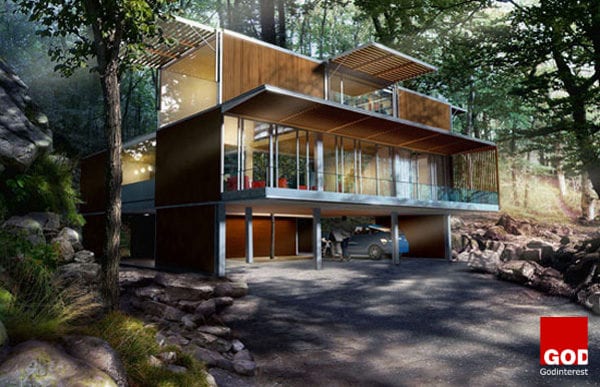
Manufactured housing is another form of factory construction. Many consumers have mistakenly referred to these homes in the past as mobile homes. Others refer to manufactured homes as trailers. Manufacturers do build these houses in a factory like modular homes on a steel chassis.
The manufacturer then transports sections of the home to the building site as completed. These dwellings are usually less expensive than both modular housing and site built housing, in part because they don’t come with a permanent foundation. Trailers and mobile homes are more likely to depreciate than modular or site built homes.
4, Advantages of Modular Construction Over Site Built
Modular homes offer many advantages over traditional site built dwellings. Many consider modular homes a hybrid breed of housing. Not a manufactured house and not a site built house, these homes offer consumers multiple benefits including costs savings, quality and convenience. In many ways modular homes surpasses site built housing in quality and efficiency.
Modulars have grown up. They are more and more becoming a mainstream selection for first time and secondary homebuyers. Most people now realise they don’t’ have to give up design quality or customization to buy a prefabricated house. One of the biggest misconceptions people have of prefabricated housing is they are look alike. “Boxy” is not a word that can begin to describe prefab dwellings. In fact, more suitable descriptions of these buidlings would include: “Elegant, durable, customised and high-class”. Many people find they can afford to include more specialization and customization when they buy a factory built house over a traditional stick built construction.
5. Cutting-edge Designs
Looking for a building design with a little pizzazz? You need to check out the latest architectural designs associated with prefabricated buildings. Firms are now building more elegant and unique designs to meet the increasing demands of selective customers. People are selecting modular designs over stick built designs to build their dream homes.
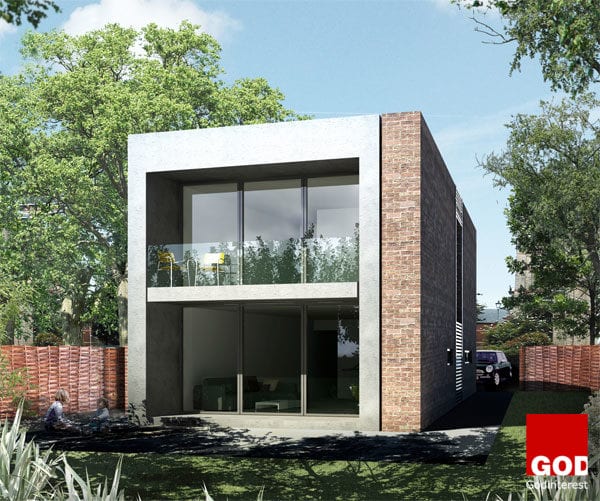
6. Customised Design and Modification
There are hundreds of companies that offer modular prefabricated construction kits and plans, and most employ various architects and specialized designers to help customize your home. That means you have more choices and a wider selection of designers to choose from. If you don’t find a style you like with one designer you can often move onto another, without even switching manufacturers.

7. Huge Range of Selection
Its always best to select a home that matches your lifestyle and design preferences.
8. Rapid Customisation
These are often the ideal selection for homeowners in need of a speedily designed homes. You simply can’t build a dwelling faster. Site built housing can take months to design and build. A manufacturer can design and place a prefab house in a few short weeks. You can pick from just as many different styles as you would a site built home if not more, but don’t have to wait weeks for contractors to build your custom house.
9. Precise Budgeting and Timing
Yet another benefit of these designs is the lack of guesswork involved. You don’t have to worry about how something will look. You know that everything will arrive to the build site complete and you will know the exact outcome. You also don’t need to worry about unexpected expenses, which is commonly the case with site built homes. With a prefabricated house, you know exactly what your home will cost and can control that cost from the point of buying to final construction. This isn’t the case with stick built housing. With stick built housing you also have to worry about surprises in the middle of construction. It isn’t uncommon for example, for a contractor to quit in the middle of a project. If this happens you have few choices.
Your home will sit partially built until you are able to find a new construction team. This alone may cost you valuable time and money.
10. Improved Energy Efficiency
Many prefab houses also come with what manufacturers call the “Energy Star” certification. This is a national company that promotes energy efficiency. Buildings with this label use 30-40 percent less energy yearly than traditional stick built housing.
This saves you time and money. Some key features of prefabricated housing that help improve energy efficiency include tight installation, high performance and weather resistant windows, controlled air systems and duct systems, upgraded air-conditioning and heating units and use of efficient lighting and heating appliances. As a bonus, these features not only save on annual energy costs but also improve the quality of your indoor air. Think energy efficiency isn’t significant? Think again. Over the lifetime of your house you could save thousands of pounds in energy bills by buying a prefabricated dwelling.
11. Design Modification is Easier
Most prefab homemakers now use computer aided design systems when conducting operations. This adds to the efficiency of construction and improves the appearance and architecture of homes. Prefabricated construction ranges from plain vanilla styling to intricate and complex modern designs.
12. On Time and on Budget
Perhaps the two biggest features or benefits of prefabricated housing that manufacturers hone in on are the speed that they can be built with and the competitive pricing they can offer on the final product. This is one reason that modular homes are gaining popularity.
13. Appreciate in Value
These dwellings also appreciate much like site built housing designs. Most homeowners are interested in building value in their house over time. Prefab housing afford you the opportunity to do this (keep in mind however much appreciation is dependent on real estate location). Select a good build site and your house will gain significant value over time. Other factors may also affect appreciation including landscaping and how well the house is cared for year after year. These factors also affect site built housing. Unlike mobile homes, which depreciate, a modular homeowner can expect to gain value from their home year after year. Study after study suggests that modular homes appreciate just as well as site built homes. They are also just as easily insured and financed.
As far as risk goes, you are no more at risk buying prefabricated housing than site built construction.
Modular Home Facts
- Modular homes appraise the same as their on-site built counterparts do.
- Modular homes can be more easilly customised.
- Most modular home companies have their own in-house engineering departments that utilize CAD (Computer Aided Design).
- Modular home designs vary in style and size.
- Modular homes are permanent structures – “real property.”
- Modular homes are considered a form of “Green Building.”
- Modular homes are faster to build than a 100% site-built home.
- Home loans for modular are the same as if buying a 100% site-built home.
- Insuring your modular home is the same as a 100% site-built home.
- Modular homes can be built to withstand 175 mph winds.
- Modular homes can be built for accessible living and designed for future conveniences.
Would you consider a modular home for yourself, or are you more of a traditionalist?
Transformation House: Former Granada Cinema, 58 St Johns Hill
Off-site manufacture of housing is not without its opponents, particularly in the traditional masonry sector who lobby hard for a site based approach which is low in capitalisation and highly responsive to the changes in economic circumstances. Prefabrication, they argue, is given unfair prominence through government support and is not the answer to the typical homeowner’s desired property. More precisely they argue that prefabricated homes are lightweight and therefore lack solidity and thermal mass and are unproven in their durability.
Transformation House: Former Granada Cinema, 58 St Johns Hill
The Grade II Star Listed Conference Centre formally the Granada Cinema has been sympathetically refurbished to portray the splendour and stunning architectural features of the original building.
Site history: Former Granada Cinema
Architect: Assael
Site area: 0.25
Gross internal area: 8,830
Number of dwellings: 59
Density: 236
Plot ratio: 1:3.5
Construction value: 15,000,000
Many attempts were made to revive this Grade II* listed building, which was on the English Heritage Buildings at Risk register. It has been vacant since 1997. All previous proposals included intrusive modifications to the magnificent listed interior.
This final proposal by Assael was based on the premise that it should allow for new construction without affecting the internal spaces. The solution was to suspend lightweight prefabricated modular residential units from full arches over the auditorium. In so doing, the auditorium would remain untouched by intrusive columns required by other more traditional construction methods. The listed ceiling would also be retained. Materials used would be glass, timber and steel. In addition, the design would ensure a total physical and acoustic separation of the uses. Within the development all residential units would have access to a terrace or balcony. Winter gardens, sun rooms and terraces have been staggered to prevent overlooking, whilst the planting between arches acts as privacy screens.
The auditorium is 34, 600 sq ft, and has the capacity for 2,500 attendees. Transformation House is surrounded by a lively mix of bars, restaurants, cafes and shops on Battersea rise, St Johns Hill, Lavender Hill and Northcote Road.
Prefab Comeback
Prefab housing suffers from bad stigma due to the fact that some people saw the prefabs as ugly and characterless, and were afraid they would become slums – hardly the promised housing fit for heroes following the second World War. However, building homes from pre-made parts can save time and money. The term prefab or prefabrication often evokes thoughts of poor construction, substandard living conditions and a long-standing “temporary” solution.
Prefab dwellings are making a comeback driven by a lack of affordable housing, a rapidly growing economy and changing demographic trends.
Methods Methods of Construction (Mmc) Offer Significant Potential to Minimise Construction Costs
The term ‘Modern Methods of Construction‘ refers to a collection of relatively new building construction techniques that aim to offer more advantages over traditional construction methods. Off-site construction (OSC) is a modern method of construction, based on off-site manufacturing of building elements.
With exponentially lower construction costs, quicker construction, reduced labor costs and having the ability to achieve zero defects, MMC is gaining a lot of attention as the potential answer to the UK’s housing crisis.
In a valiant attempt to strip away prefabricated housings’ bad rep are MMC with contemporary sleek designs, and constructed to withstand the test of time. MMC housing has the capability to deliver both quality and quantity housing to the tune of ‘ £50,000 per unit.
MMC units hold the promise of being extremely energy efficient and environmentally sustainable. Many versions of MMC take into account how to utilise natural resources and reduce each unit’s carbon footprint. In addition, MMC also addresses environmental concerns by creating much less waste than a standard brick-and-mortar project. While it is plausible that a traditional build could hire a waste removal company who would have the ability to recycle up to 90 percent of the construction waste; with MMC projects, this will automatically happen.
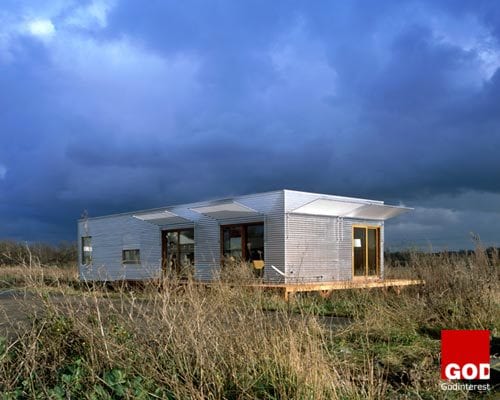
There have already been a number of successful examples of MMC housing constructed in various parts of the United Kingdom. The M-house (pronounced “mouse”) is designed and constructed to last an upwards of 100 years. While Architect Alford Hall have created quality MMC apartment buildings proudly showcasing a patio and private entrance for each flat.
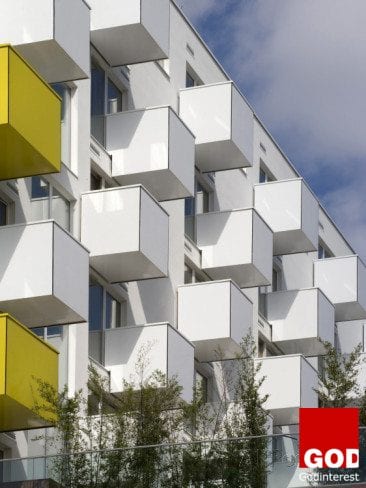
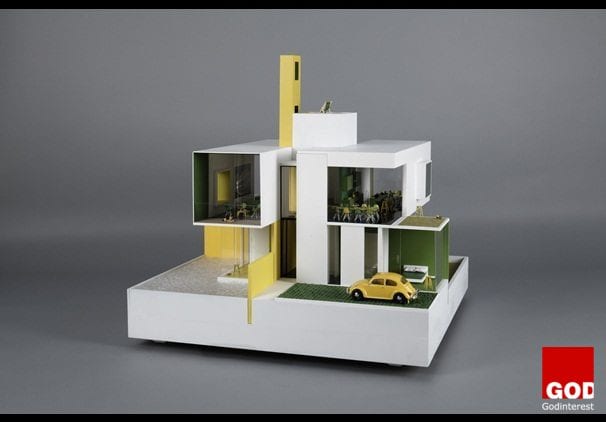
While many of the MMC homes are still in their early years the upkeep and maintenance will be reduced by 50% since the OSC process lowers the risk of non-conformities.
MMC homes are being fabricated and designed to accommodate many different lifestyles, such as, two-story homes, tall six-story apartment buildings, single-family homes and log cabins are all available options for families looking at MMC.
While there is a plethora of design options available all MMC OSC projects have a common theme. The internal workings of the homes are fabricated off-site, while only the “outer skin” comes to fruition on-site. To even further streamline the process, it has been suggested that having a “catalog of pre-selected materials increases supplier relationships and makes the design process more streamlined.”
With the small sample available with progressive MMC systems, it is currently reasonable to conclude that using modern methods of construction to build homes can cost more than traditional home building procedures; due to the need for specialised MMC design consultants. However, outside of costs, MMC remains a faster home building method than traditional brick and block house building and is slowly becoming a relevant front-runner to answer the UK’s housing shortage.
Modular Penthouse, New Inn Yard, Shoreditch
A modern approach to prefabrication is flourishing in the capital with a new generation of designers and manufacturers building on the pioneering work of organisations such as the Peabody Trust. City apartments lend themselves well to factory built components where the quality of construction needs to compensate for higher densities and restricted space for accommodation.
Offsite construction is also less disruptive in the city environment with increased construction speeds bringing a corresponding reduction in noise and transport and material handling in the neighbourhood.
It is evident that many designers are also promoting the modular unit not only as a way of producing affordable housing but also as a fashionable lifestyle product.
No more connotations of the stigmatised post-war temporary housing; the prefab is now an aspirational dwelling which is becoming increasingly desirable.
3D-modelling has also opened up mny possibilities for housing construction. The software and expertise now exists to construct houses and apartments as a virtual model before any construction work begins. It is therefore possible to join up the process of construction starting with the purchaser/occupier who make choices of layout, fittings and furnishings from the computer visualisation. Data from the virtual model then becomes specification and fabrication data which is passed to the factory and eventually delivered to site.
Modular Penthouse, New Inn Yard, Shoreditch High Street



Material efficiency and ease of construction were prime functional objectives. The Shoreditch Penthouse project explored the possibilities of inserting structures into a dense urban fabric by re-using roof tops of existing buildings. Four prefabricated volumetric units provide for various functions; they interlock on site to generate an integral live/work space in conjunction with the existing floor below. Starting with the simple idea of maximising capacity through optimisation of the existing structure, they integrate new spaces whilst sharing foundations, services and circulation areas. Core principles of sustainable construction can therefore be applied from the very beginning. Finally, through off-site construction expensive site management can be kept to a minimum, whilst maintaining a high quality of craftsmanship in a controlled factory environment.
Architect: Oceans Group
Structural Engineer: Atelier One



